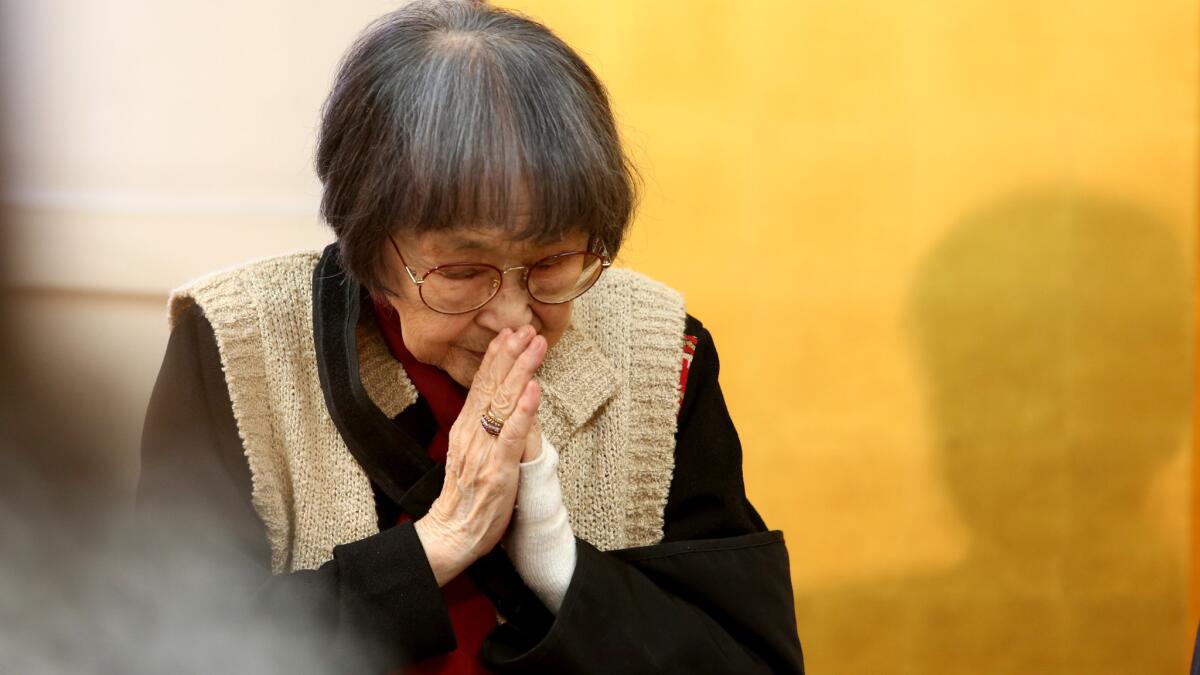As Obama tours Hiroshima, bombing survivors in Little Tokyo hope for ‘more than words’

- Share via
As President Obama prepares to become the first sitting U.S. president to visit Hiroshima since World War II, bombing survivors who gathered Sunday in Little Tokyo struggled to describe the carnage they witnessed on Aug. 6, 1945.
The bomb, they remember, fell from a sky so vibrantly blue that the B-29 bomber tracing a gray line of exhaust looked like an angel to Kaz Suyeishi, 88. Then came a painfully bright flash, explosions, collapsing buildings, blood and bodies clogging rivers. In the aftermath, the invisible threat of radiation stalked and killed survivors among the rubble.
“One by one, healthy people dying, dying, dying, dying. That’s nuclear war,” Suyeishi said.
Obama is visiting Japan to meet with world economic leaders this week, and he plans to stop at Hiroshima Peace Memorial Park and deliver remarks about war and nuclear proliferation. The visit, preceded by similar visits by U.S. Ambassador Caroline Kennedy and Secretary of State John Kerry, is controversial among those who say that dropping nuclear bombs on Hiroshima and Nagasaki helped save American and Japanese lives, and bring about an end to World War II.

But for Suyeishi and other survivors, the visit is a historic recognition of their suffering. The explosions killed 150,000 to 230,000 people by the end of 1945 and left about 200,000 survivors, according to estimates from Japanese officials.
See the most-read stories this hour >>
Some survivors of the blast in Japan have lobbied Obama to meet with them and issue a more direct public apology for what happened at the end of World War II. Besides higher rates of cancer and other health issues, their exposure to radiation has made them targets for discrimination. Many of the survivors, known as hibakusha, are unmarried and childless, ostracized because of public concern over potential health issues.
One by one, healthy people dying, dying, dying, dying. That’s nuclear war.
— Kaz Suyeishi, Hiroshima survivor
But Obama, wrote deputy national security advisor Ben Rhodes in a Medium post, “will not revisit the decision to use the atomic bomb at the end of World War II.”
The visit is intended to “shine a spotlight on the tremendous and devastating human toll of war,” as well as highlight the cause of nuclear disarmament, Rhodes wrote.
Japan’s Prime Minister Shinzo Abe has also indicated that achieving a nuclear-free world is more important to Japan than seeking an apology from the United States.
The horrors of Hiroshima cannot be erased with an apology, agreed Junji Sarashina, an 87-year-old survivor.
Sarashina was 16 years old and 1.5 miles from the center of the explosion when the bomb was dropped on Hiroshima. He remembers wandering around the city looking for survivors in the rubble, unaware that radiation was creeping into his body. He can’t forget what he saw, he said: school yards with bodies piled high, hospitals with doctors and nurses too sick to help patients, a dead woman curled around her baby in the middle of the street, both charred black by the blast.
“An apology is not a solution,” Sarashina said.
Whether Obama apologizes is just political semantics to bombing survivor Wataru Namba. Namba was 18 at the time of the blast and just 1.2 miles away from its center. His cousin died of radiation poisoning, and he himself was so weakened by radiation exposure that for months, he lacked the energy to shoo flies away from his face.
Obama’s visit, Namba believes, is a step toward preventing it from ever happening again.
“It gives me a warm heart. That despite all the politicians and WWII veterans that may be upset, he is still going. It means he has a heart,” Namba said.
Sarashina, Namba and Suyeishi are part of the American Society of Hiroshima-Nagasaki A-Bomb Survivors, which has about 200 members in Los Angeles. The nonprofit group’s members periodically revisit their experiences to raise awareness for the cause of nuclear disarmament. They also organize yearly checkups for Hiroshima and Nagasaki survivors, and every other year, they help bring a team of doctors from Hiroshima who specialize in the long-term effects of radiation to examine the group’s members. After Obama announced his visit to Hiroshima, they sent 200 postcards to the White House in gratitude.
But the visit has to lead to action, said Sarashina, who is battling stomach cancer, a byproduct of radiation exposure in Hiroshima.
“It’s a step toward something good in the future. I hope it’s going to be more than words,” Sarashina said.
Twitter: @frankshyong
ALSO
Japan doesn’t want the U.S. to apologize for bombing Hiroshima. Here’s why
Obama will be first U.S. president to visit Hiroshima — but he’ll make no apologies
Obama heads to Vietnam and Japan to confront the ghosts of old wars amid turmoil in modern ones
More to Read
Sign up for Essential California
The most important California stories and recommendations in your inbox every morning.
You may occasionally receive promotional content from the Los Angeles Times.











